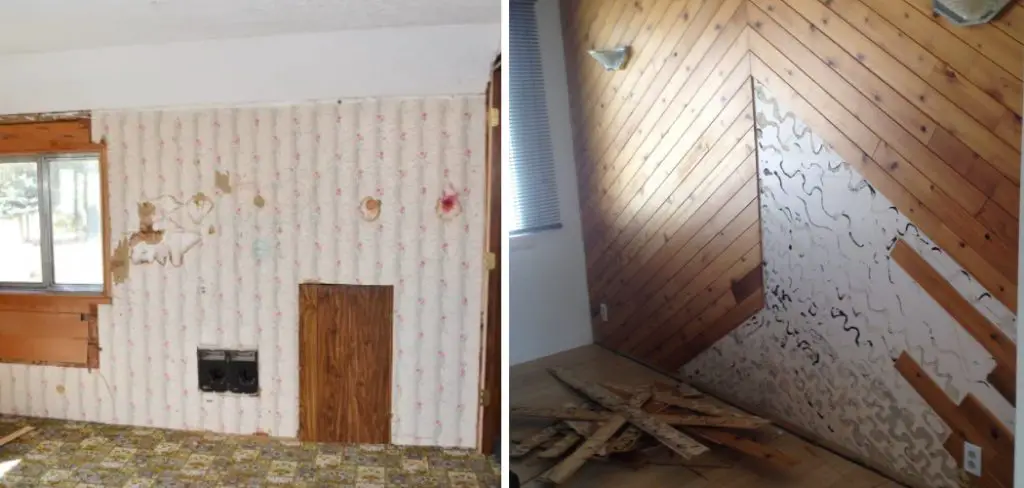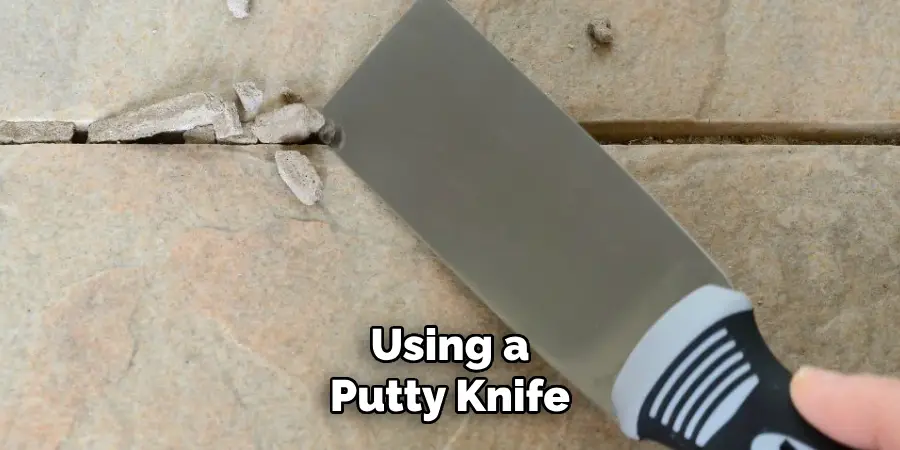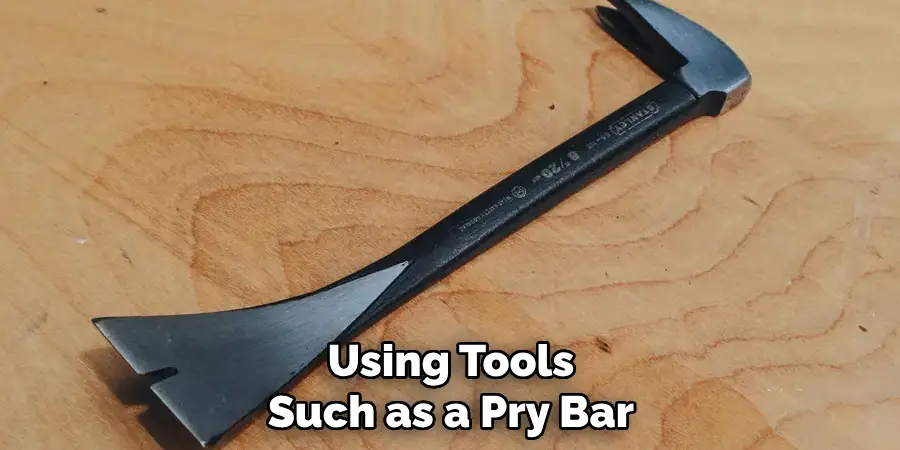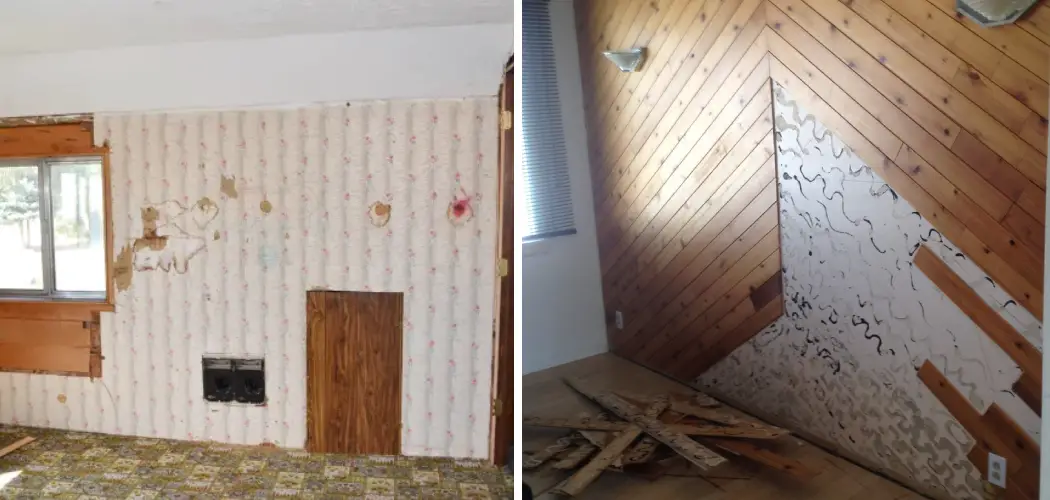Removing wood panels from walls is a common practice when renovating or remodeling a room. It can also be necessary if the wood panels are damaged, outdated, or no longer fit the desired aesthetic of the space. Removing wood panels may seem like a daunting task, but with the right tools and techniques, it can be a straightforward process.

The main advantage of learning to remove wood panels from walls is that it gives you the ability to make updates and changes to your home without having to rely on a professional for help. By knowing how to remove wood panels, you can easily transform the appearance of any room in your house and add value to your property. You can find step-by-step instructions on how to remove wood panels from walls in this blog article.
Tools You Will Need
- Pry bar
- Hammer
- Utility knife
- Putty knife
- Screwdriver (flathead or Phillips)
- Sander (orbital or belt)
- Dust mask
- Safety glasses or goggles
- Gloves (work gloves and/or disposable gloves depending on the task at hand)
- Drop cloth
Step-by-step Instructions for How to Remove Wood Panels From Walls
Step 1: Inspect the Wood Panel
Before you begin removing any wood panels, it is essential to inspect them first. Look for any signs of damage or wear and tear, as well as how they are attached to the wall. This will help you determine the best approach for removing them.
Step 2: Gather Tools and Materials
To remove wood panels from walls, you will need some basic tools and materials. These include a hammer, pry bar, putty knife, utility knife, and sandpaper. You may also need safety goggles and work gloves for protection.
Step 3: Prepare the Work Area
It is important to prepare the work area before you start removing the wood panels. Cover any nearby furniture or flooring with drop cloths to protect them from potential damage. Also, make sure you have enough space to safely maneuver while working.

Step 4: Start With the Trim
If your wood panels have trim pieces around the edges, it is best to start by removing them first. Use a utility knife to score along the edges of the trim and then gently pry it off using a putty knife or hammer. Once the trim is removed, you can locate the studs behind the wood panels. Use a stud finder or tap on the walls to find where they are located. Mark these spots with a pencil for reference.
Step 5: Remove Baseboard and Trim Pieces
Next, remove the baseboard and any other trim pieces attached to the wood panels. Be careful not to damage them as they may be reused later. You can use a pry bar or hammer to gently remove these items.
Now it is time to actually remove the wood panels from the wall. Use a pry bar or hammer to gently pry them away from the wall, starting at one of the corners. Work your way along the edges until they are completely detached.
Step 6: Remove Nails and Adhesive
After removing the panels, you will likely have some nails or adhesive left behind on the wall. Use a putty knife or the claw of a hammer to remove any remaining nails. You can also use sandpaper to remove any adhesive residue.
Once all the wood panels are removed, clean the wall thoroughly with a damp cloth to remove any dust or debris. If there are any holes left from nails or screws, fill them with spackling paste and sand them down for a smooth surface.
Step 7: Finish the Wall
Now that your wall is clean and prepped, you can either paint or install new panels over it. If painting, make sure to prime the wall first before applying your chosen color. If installing new panels, follow the manufacturer’s instructions carefully for proper installation.
By following these step-by-step instructions, you can easily remove wood panels from walls and transform the look of your space. Remember to always work carefully and take necessary safety precautions for a successful project.
Tips for How to Remove Wood Panels From Walls
- Wear protective gear such as safety goggles and work gloves to avoid any injuries.
- Use caution when handling sharp tools such as a utility knife or pry bar.
- Make sure the work area is well-ventilated and use appropriate respiratory protection if needed.
- Avoid using excessive force when removing panels to prevent damage to the wall or yourself.
- If you encounter any electrical wiring behind the panels, turn off the power to that area before continuing.
- If the wood panels are old, be aware that they may contain lead-based paint. Take proper precautions when handling and disposing of them.
- Keep children and pets away from the work area for their safety.

Remember to always prioritize safety while working on any home improvement project. If you feel unsure about removing wood panels from walls, it is best to consult a professional for assistance.
What Are Some Common Mistakes to Avoid When Removing Wood Panels From Walls?
Wood paneling can add a warm and cozy touch to any room, but there may come a time when you want to remove it. Whether you’re looking to update your home or simply tired of the outdated look, removing wood panels from walls is a relatively straightforward process that can be done on your own.
Many people opt to hire a professional for this task, thinking that it is too difficult or time-consuming to do themselves. While hiring a professional can certainly save you time and effort, it may not always be necessary. With the right tools and techniques, you can successfully remove wood panels from walls without breaking the bank.
1. Not Preparing the Room Properly
Before you even begin removing wood panels from walls, it’s important to properly prepare the room. This means removing all furniture and coverings such as curtains or blinds. You’ll also want to lay down drop cloths or plastic sheets to protect the floor from any potential damage or debris.
Additionally, make sure to wear appropriate clothing and protective gear such as gloves and safety goggles. Some wood panels may be nailed or glued to the wall, so there is a possibility of small pieces breaking off during removal.
2. Not Knowing What’s Behind the Panels
Before you start removing wood panels from walls, it’s essential to know what’s behind them. In some cases, there may be electrical wiring, plumbing pipes, or other important structures hidden behind the panels. If you’re unsure, it’s best to consult a professional before proceeding.
3. Using Improper Tools
Using the right tools can make all the difference when removing wood panels from walls. A pry bar and hammer are the most commonly used tools for this task. However, it’s important to choose the right size and type of pry bar for your specific project.

Using a tool that is too large or not designed for wood panel removal can result in damage to both the panels and the wall itself. It’s also important to use caution when using these tools to avoid injury.
4. Not Removing Nails or Glue Properly
Once the wood panels are removed, you may be left with nails or adhesive residue on the walls. It’s important to remove these properly to avoid any potential damage to the wall surface.
For nails, use a hammer and gently tap them back through the wood panel until they are flush with the wall. You can then use a putty knife or pry bar to remove any leftover pieces. For adhesive residue, use a heat gun or chemical adhesive remover and follow the manufacturer’s instructions carefully.
How Do You Prevent Damage to Surrounding Areas While Removing Wood Panels From Walls?
To prevent damage to surrounding areas while removing wood panels from walls, it’s important to take proper precautions and use the right techniques. First and foremost, make sure to protect floors and furniture by laying down drop cloths or plastic sheets before starting the removal process.
When using tools such as a pry bar or hammer, be careful not to hit the wall surface too hard as this can cause damage. It’s also helpful to start at a corner or seam and work your way along the panel, rather than trying to remove it all at once.

If you encounter any unexpected obstacles, such as electrical wiring or plumbing pipes, stop and consult a professional before proceeding.
Taking these steps can help avoid costly repairs down the road. In addition, when removing adhesive residue from the walls, it’s important to do so carefully. Using too much heat or harsh chemicals can damage the wall surface, so be sure to follow instructions closely and test a small area first.
Final Thoughts
Removing wood panels from walls can be a satisfying and budget-friendly way to update your home. By avoiding these common mistakes and taking the necessary precautions, you can successfully complete this task on your own.
Before starting, make sure to gather all necessary tools and materials and have a clear plan in place. Take your time and be patient as it may require some effort and elbow grease.
In conclusion, knowing to remove wood panels from walls can come in handy for any DIY home renovation project. With the right approach and techniques, you can transform your walls and give your space a fresh new look without breaking the bank.
So go ahead and confidently tackle this task, and enjoy the sense of accomplishment that comes with successfully completing a DIY project. I hope reading this post has helped you learn how to remove wood panels from walls. Make sure the safety precautions are carried out in the order listed.

